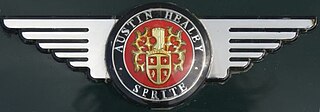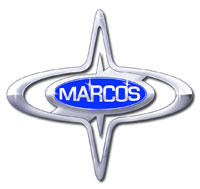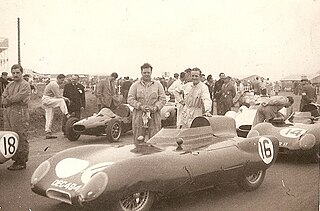
The Ford GT40 is a high-performance endurance racing car commissioned by the Ford Motor Company. It grew out of the "Ford GT" project, an effort to compete in races against historic cars, most notably against Ferrari, which won the prestigious 24 Hours of Le Mans race from 1960 to 1965. Ford succeeded with the GT40, winning the 1966 through 1969 races.

TVR is a British manufacturer of high-end sports cars. The company manufactures lightweight sports cars with powerful engines and was, at one time, the third-largest specialised sports car manufacturer in the world, offering a diverse range of coupés and convertibles.

The AC Cobra, sold in the United States as the Shelby Cobra and AC Shelby Cobra, is a sports car manufactured by British company AC Cars, with a Ford V8 engine. It was produced intermittently in both the United Kingdom and later the United States since 1962.

The Austin-Healey Sprite is a small open sports car produced in the United Kingdom from 1958 until 1971. The Sprite was announced to the press in Monte Carlo by the British Motor Corporation on 20 May 1958, two days after that year's Monaco Grand Prix. It was intended to be a low-cost model that "a chap could keep in his bike shed", yet be the successor to the sporting versions of the pre-war Austin Seven. The Sprite was designed by the Donald Healey Motor Company, with production being undertaken at the MG factory at Abingdon. It first went on sale at a price of £669, using a tuned version of the Austin A-Series engine and as many other components from existing cars as possible to keep costs down.

Marcos Engineering was a British sports car manufacturer. The name derives from the surnames of founders Jem Marsh and Frank Costin.
Lotus Cortina is the commonly used term for the Ford Cortina Lotus, a high-performance sports saloon, which was produced in the United Kingdom from 1963 to 1970 by Ford in collaboration with Lotus Cars. The original version, which was based on the Ford Cortina Mark 1, was promoted by Ford as the "Consul Cortina developed by Lotus", with "Consul" later being dropped from the name. The Mark 2 was based on the Ford Cortina Mark II and was marketed by Ford as the "Cortina Lotus". Lotus gave the model the type number designation Type 28.

Ashley were manufacturers of body shells and chassis for specials from 1955 to 1962. They also offered a range of products for special builds: radiators, header tanks, lighting sets, steel tubing, sheet aluminium, various suspension parts, water pumps, tires, tubes and wheels. The company also made bonnets and hardtops for other mass-produced sports cars, including the Austin-Healey Sprite and Jaguar E-Type.

Coventry Climax was a British forklift truck, fire pump, racing, and other specialty engine manufacturer.

The Triumph Herald is a small two-door car introduced by Standard-Triumph of Coventry in 1959 and made through to 1971. The body design was by the Italian stylist Giovanni Michelotti, and the car was offered in saloon, convertible, coupé, estate and van models, with the latter marketed as the Triumph Courier.

Elva was a sports and racing car manufacturing company based in Bexhill, then Hastings and Rye, East Sussex, United Kingdom. The company was founded in 1955 by Frank G. Nichols. The name comes from the French phrase elle va.

The Lotus 17 was a sports car racing model built by Lotus Cars in 1959. Designed by Len Terry, it was built in response to the Lola Mk1 which was dominant against the previous Lotus model, the Eleven. It was replaced in 1960 by the Lotus 19.

Fairthorpe cars were made in Chalfont St Peter, Buckinghamshire, England between 1954 and 1961, from 1961 to 1973 in Denham, Buckinghamshire.

Gilbern, Gilbern Sports Cars (Components) Ltd , was a Welsh car manufacturer from 1959 to 1973, based in Llantwit Fardre, Pontypridd, Glamorgan, Wales.

Ginetta Cars Limited is a British specialist builder of racing and sports cars based in Garforth, Leeds, West Yorkshire.

Rochdale cars were a series of mainly glass fibre bodied British sports car made by Rochdale Motor Panels and Engineering in Rochdale, Greater Manchester, England between 1948 and 1973. The company is best remembered for the Olympic coupé made between 1959 and 1973.

The TVR Grantura is the first production model in a long line of TVR cars. It debuted in 1958 and went through a series of developments leading to the Mark I to Mark IV and 1800S models. The last ones were made in September 1967.

The Lotus 18 was a race car designed by Colin Chapman for use by Lotus in Formula Junior, Formula Two, and Formula One.
Eric Harrison Broadley MBE was a British entrepreneur, engineer, and founder and chief designer of Lola Cars, the motor racing manufacturer and engineering company. He was arguably one of the most influential automobile designers of the post-war period, and over the years Lola was involved with many high-profile projects in Formula One, IndyCar, and sports car racing. Broadley sold Lola to Martin Birrane in 1999.

The Eagle Mk1, commonly referred to as the Eagle T1G, was a Formula One racing car, designed by Len Terry for Dan Gurney's Anglo American Racers team. The Eagle, introduced for the start of the 1966 Formula One season, is often regarded as being one of the most beautiful Grand Prix cars ever raced at the top levels of international motorsport. Initially appearing with a 2.7L Coventry Climax inline 4-cylinder engine, the car was designed around a 3.0L Gurney-Weslake V12 which was introduced after its first four races. In the hands of team boss Gurney, the Eagle-Weslake won the 1967 Belgian Grand Prix, making Dan Gurney only the second driver at the time, and one of only three to date, to win a Formula One Grand Prix in a car of their own construction. That win in Belgium still stands as the only win for a USA-built car as well as one of only two wins of an American-licensed constructor in Formula One.

John Crosthwaite was an English race car designer and engineer, active in both the United Kingdom and the United States.




















